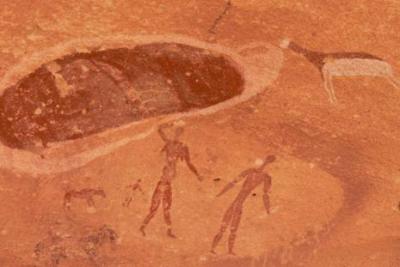History & Heritage
4.11.2022
Egypt: Why is the “cave of the swimmers” still a total mystery?

It has been studied since its discovery in 1933 but continues to arouse incomprehension and astonishment among archaeologists. The cave of the swimmers, located in the Western Sahara, has preserved its share of mystery…
The cave of the swimmers is a site of very known rock art of the Western Sahara, in the extreme West of Egypt. On the ochre walls of the cave, one can distinguish innumerable drawings representing characters and animals, among which a category is particularly distinguished: the swimmers.
They are so called because they are depicted as lying on their stomachs, arms and legs horizontally, in a movement that looks very much like swimming. From then on, it seems normal to wonder about the possibilities of swimming, probably very limited in one of the most arid regions of one of the most arid deserts of the world…

Caption: Are these people shown swimming, or floating?
Credits: John Zada / Alamy / Photo 12
Topographical evolution
First of all, it is important to understand that the land did not look like the harsh sandy plain we know today. If we go back in time some 10,000 years, we find ourselves in the middle of a savannah inhabited by all sorts of animals and men. These animals are also abundantly represented in these rock paintings, often without heads, or with scribbled heads.
So, real swimmers of the surrounding lakes or creatures surrounded by a more mystical aura? The archaeologists have not yet arrived at a consensus. Where some see a representation of the deceased arriving in the afterlife -welcomed by these same headless animals that would therefore be gods-; others see a magical practice, a way of neutralizing the power of the image, in order not to give life to dangerous or demonic creatures by representing them without this correction.
But isn’t it precisely this uncertainty that makes the visit to these places, and the study of these engravings, all the more fascinating?
popular

